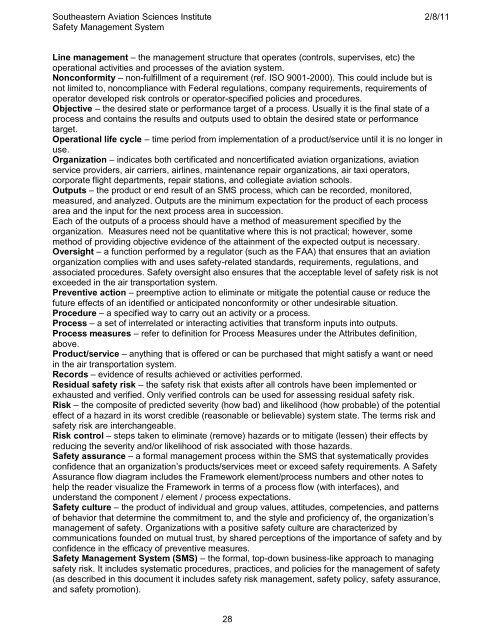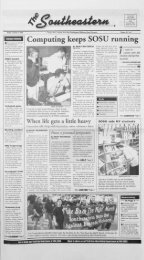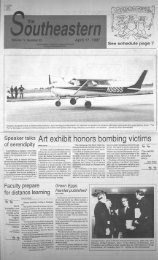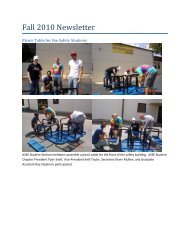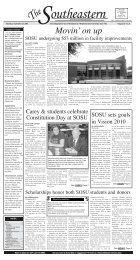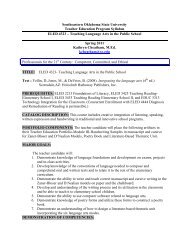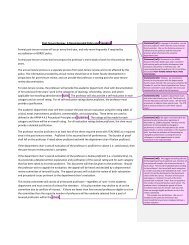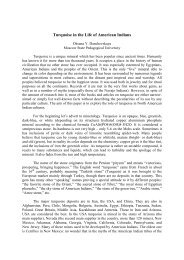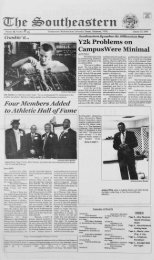Southeastern Aviation Safety Management System
Southeastern Aviation Safety Management System
Southeastern Aviation Safety Management System
You also want an ePaper? Increase the reach of your titles
YUMPU automatically turns print PDFs into web optimized ePapers that Google loves.
<strong>Southeastern</strong> <strong>Aviation</strong> Sciences Institute 2/8/11<br />
<strong>Safety</strong> <strong>Management</strong> <strong>System</strong><br />
Line management – the management structure that operates (controls, supervises, etc) the<br />
operational activities and processes of the aviation system.<br />
Nonconformity – non-fulfillment of a requirement (ref. ISO 9001-2000). This could include but is<br />
not limited to, noncompliance with Federal regulations, company requirements, requirements of<br />
operator developed risk controls or operator-specified policies and procedures.<br />
Objective – the desired state or performance target of a process. Usually it is the final state of a<br />
process and contains the results and outputs used to obtain the desired state or performance<br />
target.<br />
Operational life cycle – time period from implementation of a product/service until it is no longer in<br />
use.<br />
Organization – indicates both certificated and noncertificated aviation organizations, aviation<br />
service providers, air carriers, airlines, maintenance repair organizations, air taxi operators,<br />
corporate flight departments, repair stations, and collegiate aviation schools.<br />
Outputs – the product or end result of an SMS process, which can be recorded, monitored,<br />
measured, and analyzed. Outputs are the minimum expectation for the product of each process<br />
area and the input for the next process area in succession.<br />
Each of the outputs of a process should have a method of measurement specified by the<br />
organization. Measures need not be quantitative where this is not practical; however, some<br />
method of providing objective evidence of the attainment of the expected output is necessary.<br />
Oversight – a function performed by a regulator (such as the FAA) that ensures that an aviation<br />
organization complies with and uses safety-related standards, requirements, regulations, and<br />
associated procedures. <strong>Safety</strong> oversight also ensures that the acceptable level of safety risk is not<br />
exceeded in the air transportation system.<br />
Preventive action – preemptive action to eliminate or mitigate the potential cause or reduce the<br />
future effects of an identified or anticipated nonconformity or other undesirable situation.<br />
Procedure – a specified way to carry out an activity or a process.<br />
Process – a set of interrelated or interacting activities that transform inputs into outputs.<br />
Process measures – refer to definition for Process Measures under the Attributes definition,<br />
above.<br />
Product/service – anything that is offered or can be purchased that might satisfy a want or need<br />
in the air transportation system.<br />
Records – evidence of results achieved or activities performed.<br />
Residual safety risk – the safety risk that exists after all controls have been implemented or<br />
exhausted and verified. Only verified controls can be used for assessing residual safety risk.<br />
Risk – the composite of predicted severity (how bad) and likelihood (how probable) of the potential<br />
effect of a hazard in its worst credible (reasonable or believable) system state. The terms risk and<br />
safety risk are interchangeable.<br />
Risk control – steps taken to eliminate (remove) hazards or to mitigate (lessen) their effects by<br />
reducing the severity and/or likelihood of risk associated with those hazards.<br />
<strong>Safety</strong> assurance – a formal management process within the SMS that systematically provides<br />
confidence that an organization’s products/services meet or exceed safety requirements. A <strong>Safety</strong><br />
Assurance flow diagram includes the Framework element/process numbers and other notes to<br />
help the reader visualize the Framework in terms of a process flow (with interfaces), and<br />
understand the component / element / process expectations.<br />
<strong>Safety</strong> culture – the product of individual and group values, attitudes, competencies, and patterns<br />
of behavior that determine the commitment to, and the style and proficiency of, the organization’s<br />
management of safety. Organizations with a positive safety culture are characterized by<br />
communications founded on mutual trust, by shared perceptions of the importance of safety and by<br />
confidence in the efficacy of preventive measures.<br />
<strong>Safety</strong> <strong>Management</strong> <strong>System</strong> (SMS) – the formal, top-down business-like approach to managing<br />
safety risk. It includes systematic procedures, practices, and policies for the management of safety<br />
(as described in this document it includes safety risk management, safety policy, safety assurance,<br />
and safety promotion).<br />
28


